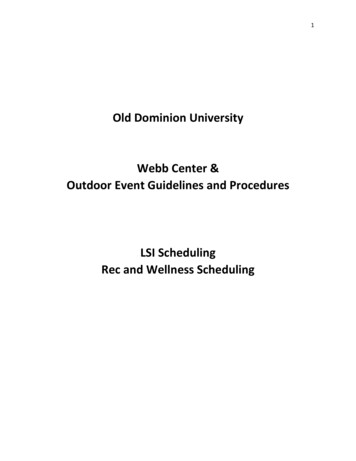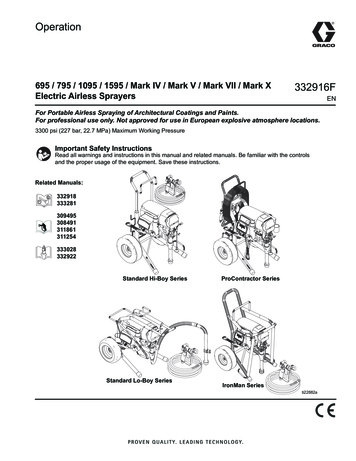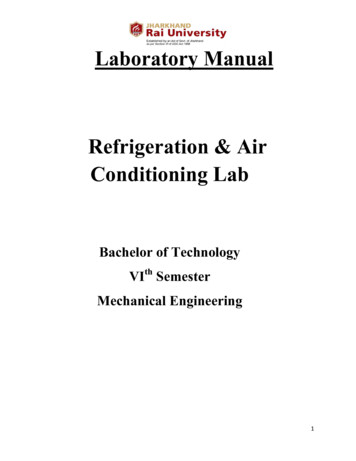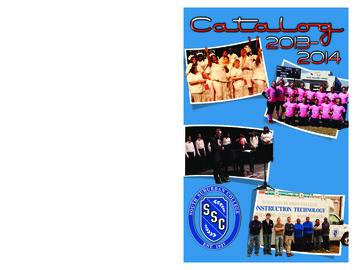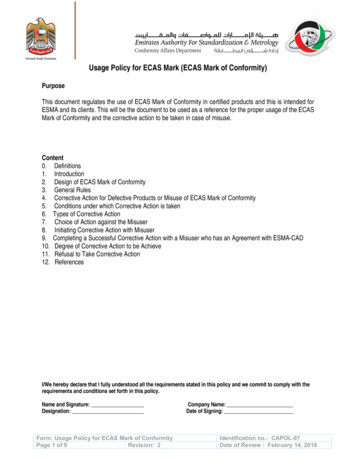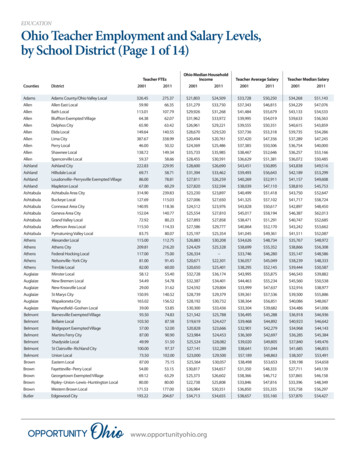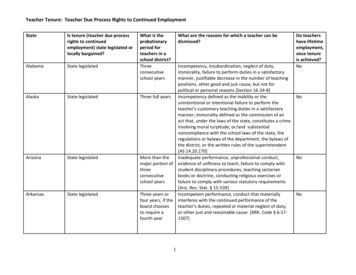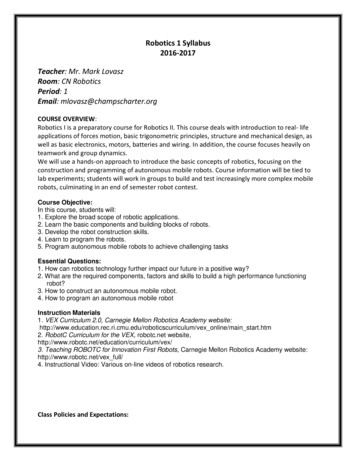
Transcription
Robotics 1 Syllabus2016-2017Teacher: Mr. Mark LovaszRoom: CN RoboticsPeriod: 1Email: mlovasz@champscharter.orgCOURSE OVERVIEW:Robotics I is a preparatory course for Robotics II. This course deals with introduction to real- lifeapplications of forces motion, basic trigonometric principles, structure and mechanical design, aswell as basic electronics, motors, batteries and wiring. In addition, the course focuses heavily onteamwork and group dynamics.We will use a hands-on approach to introduce the basic concepts of robotics, focusing on theconstruction and programming of autonomous mobile robots. Course information will be tied tolab experiments; students will work in groups to build and test increasingly more complex mobilerobots, culminating in an end of semester robot contest.Course Objective:In this course, students will:1. Explore the broad scope of robotic applications.2. Learn the basic components and building blocks of robots.3. Develop the robot construction skills.4. Learn to program the robots.5. Program autonomous mobile robots to achieve challenging tasksEssential Questions:1. How can robotics technology further impact our future in a positive way?2. What are the required components, factors and skills to build a high performance functioningrobot?3. How to construct an autonomous mobile robot.4. How to program an autonomous mobile robotInstruction Materials1. VEX Curriculum 2.0, Carnegie Mellon Robotics Academy cscurriculum/vex online/main start.htm2. RobotC Curriculum for the VEX, robotc.net /vex/3. Teaching ROBOTC for Innovation First Robots, Carnegie Mellon Robotics Academy website:http://www.robotc.net/vex full/4. Instructional Video: Various on-line videos of robotics research.Class Policies and Expectations:
1. Attendance: Perfect attendance is strongly recommended. Arrive to class on time –Tardiness,without a pass, will be reported to the office. (see student handbook).2. Be prepared to work-Bring all appropriate materials to class (Engineer’s Notebook/Binder andpencil). Immediately take you assigned seat.Daily objectives are posted in classroom.3. Pay attention–All lectures and demonstrations are important. These concepts willbe built upon. Lab demonstrations are extremely important because they often involve your safetyand the safety of everyone else in the lab.4. Food or drink - Prohibited.5. Electronic devices - Prohibited. Unless required in lesson. Ex. Use cell or digital camera tocapture evidence of work to upload to ePortfolio.6. Computers – Are available and used regularly. Students must follow internet usage policy. (seestudent hand book) Students caught using computer for reasons other than associated withclassroom assignment (during assignment) will fail that assignment. Example: Playing gamesduring programming of robot or during instructional time. Students who change settings oncomputer will not receive help until settings are set back.7. Assessments – Include, but are not limited to, group and/or individual classroom assignments,tests, quizzes (on-line), portfolios, e-portfolio, engineers book and lab assignments. Students mustsuccessfully complete a safety quiz (100%) on specific machinery that they will use in the lab.Failure to successfully complete this assessment will not affect their grade, but will prohibit themfrom using this machine in any lab situation.8. Student’s responsibility –Each student is responsible for his/her actions. Each student shouldmonitor their progress utilizing Q.It is the student’s responsibility to make up any incomplete assignment(s). To be successful in myclass, you must complete all assignments.9. Follow all lab policies and procedures –Lab policies and procedures are posted throughout thelab. They are then discussed, reviewed and tested in great detail within each course. This includes(but is not limited to) machine/material/tool use, clean up procedures, behavior, lab dress code,and the safety of the individual students and class. Violation of any of these policies/ procedureswill not be tolerated. Any violations will be reported to the office and will result in an immediateand permanent removal from class. All students will be closely supervised in classroom and labsituations. It is extremely important that the parent/guardian emphasize, to their child, theimportance of appropriate behavior in all lab situations to support classroom instruction.Approved safety glasses, provided, must be worn in the lab at all times.CLASSROOM ROUTINES AND PROCEDURES:
BEGINNING OF CLASS: Bring textbook, all necessary materials (including paper, pencil, pen, binder, activitynotebook, etc.), and your brain to class every day. Turn in your homework and take your seat before the bell rings. Copy down the objective and the warm-up question. Remove hats. Once the bell rings start on the Warm-Up. Work silently.ENTERING TARDY POLICY: Upon entering class do not interrupt the teacher or the class Sign the Tardy Sign In Sheet After signing in, immediately begin copying the objective and the agenda or Get materials for the day (if you need them)RESTROOM POLICY: Students must have a hall pass at all times! No bathroom passes for the first and last 10 minutes of class. Do not interrupt the instructor; wait until a transition in class before requesting a restroompass. Raise your hand before getting out of your seat. Each student is expected to return within 5 minutes.EXITING THE CLASSROOM: The final 5 minutes of class time will be used for cleaning. Make sure you put all your materials away. The bell does not dismiss you! Your instructor will dismiss the class by table when theequipment has been returned, the room is clean, and all students are seated or standing byin their assigned seats.ASSIGNMENTS:Class work: I will provide a storage space to keep all class work. The classwork will be collectedand graded at the end of the week. Graded work will be returned the following week.Labs/Experiments: Assignments must be turned in at the beginning of class on the due date.Although you and your lab partners will have identical data, each student is expected to do his orher own work. The written format will be explained with the first experiment.Homework: Homework will be assigned weekly to provide students the opportunity to test theirunderstanding and practice applying their skills.Late work: All assignments are due at the beginning of class on the day they are due. Studentswho wish to submit late work must see me to make arrangements. However, NO late work will beaccepted after grades have been submitted for progress reports/report cards.Make-up work: When absent, students are responsible for retrieving missing work.GRADING POLICY:
Evaluation:35%30%25%10%Engineering NotebooksProjectsTeamworkFinal ExamNote that the percentages are approximate –the course is graded on a total point system. Please be awarethat a missed assignment, lab or test results in zero points for that assignment, while at least some pointswill be given for working on an assignment, even if it is not completed when turned inTopics Covered:1. Intro to Robotics2. Forces3. Free Body Diagrams4. Basics for Center of Mass5. Basics for Statics6. Kinematics7. Dynamics8. Machines9. Structural Components10. Sensors13. Signals14. CurrentNOTE: The class is about opportunity while the team depends on your responsibility. Both of theserequire that you participate. With so many projects and events, there is certainly plenty foreveryone to do! In many cases, decisions are made by the team as a whole –so be sure to speakup and let your opinion be known.Lab Safety Rules: PLEASE READ THESE CAREFULLY!
1. Always read instructions carefully. Stay on task; cooperatively work together as a team.2. Do not eat or drink in the lab or classroom at anytime unless you need it due to medicalcondition.3. Do not bring backpacks or purses into the working area for any reason.4. Never touch electrical outlets or handle electrical cords with wet hands.5. Always clean up after yourself during labs.6. Know what to do in case of a fire alarm.7. Report ALL accidents to your teacher – no matter how small!I acknowledge the expectations of this classroom and my responsibilities as a student ofCHAMPS High School. I will give my best effort to fulfill these expectations andresponsibilities. I have read the syllabus and understood the rules of safety. I will actappropriately and follow all safety procedures. I understand that I will not be allowed to workin the lab unless I have signed this document.Teacher reserves the right to amend any part of this syllabus.After reading this document, please sign and return the portion below:Student:I have read the guidelines and will honor both the policies and the consequences while inMr. Lovasz’s class.Student name: Signature:Parent:I have read the guidelines and policies with my child, and will support both the rules andthe consequences.Parent name: Signature:Home phone: Cell:
Robotics 1 Syllabus 2016-2017 Teacher: Mr. Mark Lovasz Room: CN Robotics Period: 1 Email: mlovasz@champscharter.org COURSE OVERVIEW: Robotics I is a preparatory course for Robotics II. This course deals with introduction to real- life
